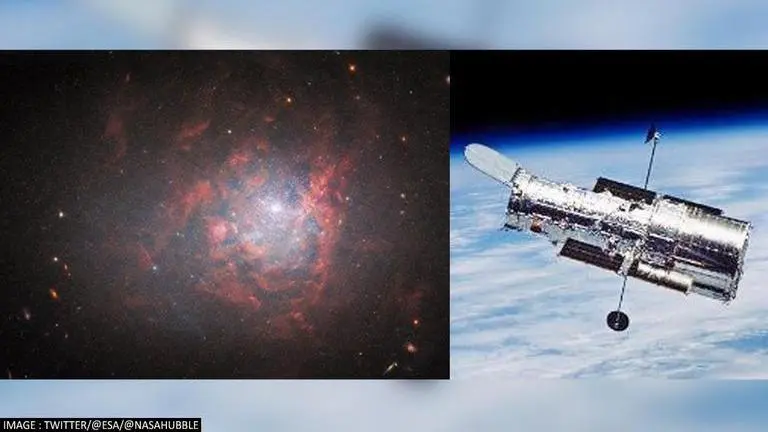Updated 2 February 2022 at 09:35 IST
Hubble Space Telescope captures 'cosmic oddball' dwarf galaxy that underwent starburst
NASA’s Hubble Space Telescope has managed to take an updated photo of the dwarf galaxy NGC 1705, which is located some 17 million light-years away from Earth.
- World News
- 2 min read

NASA’s Hubble Space Telescope has managed to take an updated photo of the dwarf galaxy NGC 1705, which is located some 17 million light-years away from Earth in the constellation Pictor. In the new image, the dwarf galaxy shines in a cloud of bright light and red colours. The tiny, irregularly-shaped galaxy is what the European Space Agency (ESA) has described as a “cosmic oddball”.
The ESA informed that the NGC 1705 went through a “starburst” phase recently, meaning it was experiencing a usually high rate of star formation. In the image, the dwarf galaxy is surrounded by red cosmic “clouds” is highlighted by bright starlight. The European space agency believes that NGC 1705 and other dwarf galaxies like it can now provide valuable insights into the overall evolution of galaxies.
“The data shown in this image come from a series of observations designed to unveil the interplay between stars, star clusters, and ionised gas in nearby star-forming galaxies,” ESA said.
📷 This image from the NASA/ESA @HUBBLE_space Telescope shows dwarf galaxy NGC 1705 — small, irregularly shaped, and having recently undergone a spate of star formation, it's known as a 'starburst galaxy' 👉 https://t.co/uJX6JttPJj pic.twitter.com/onB36AejvM
— ESA (@esa) January 31, 2022
New observations can provide complete look at the galaxy
Further, the space agency explained that irregular dwarf galaxies like the NGC 1705 have fewer elements than larger galaxies and consist mostly of hydrogen and helium. Due to this, they are thought to be similar to the universe’s earliest galaxies.
Meanwhile, it is to mention that Hubble is one of the most advanced telescopes at scientists’ disposal. Notably, Hubble took picture of NGC 1705 was in 1999 when astronomers used the telescope's camera (at the time, the Wide Field Planetary Camera 2) to observe the galaxy's centre. Now, the scientists believe that the new observations, which use much newer technology on Hubble, can provide more detail and a more complete look at the galaxy.
Advertisement
In December 2021, NASA, ESA, and the Canadian Space Agency (CSA) also jointly launched the James Webb Space Telescope, which possesses improved infrared resolution and advanced sensitivity compared to Hubble, which it is eventually expected to replace.
(Image: @esa/Twitter)
Published By : Bhavya Sukheja
Published On: 2 February 2022 at 09:35 IST
